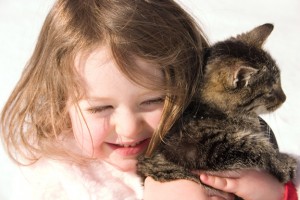Saying Goodbye to a Beloved Pet
Whether it’s a fish, rat, hamster, dog, or a cat, losing a pet is painful. Learn how to help your children cope with the loss.
The unconditional love expressed between a pet and a young child is a lovely thing to observe. When a beloved family pet passes away, it may be the first time that a child experiences the reality of death. This is often a time of great sadness for a young child and confusion for many parents, who are faced with an appropriate way to explain to a child where their family companion has gone. With a little practical advice and lots of care and concern on your part, you can help your little ones learn to conquer their fears and worries.
A Toddler’s Behavior
Infants and children under two years of age have no concept of death, so when a furry friend is suddenly gone, they may exhibit little interest. However, according to Scott Mitchell, licensed clinical social worker at Arnold Palmer Hospital for Women & Children in Orlando, one to two year olds are influenced by the reactions of their loved ones. He advises parents to be aware of the grief and tension in the house, as well as their own emotional state that children often observe and may not understand.
exhibit little interest. However, according to Scott Mitchell, licensed clinical social worker at Arnold Palmer Hospital for Women & Children in Orlando, one to two year olds are influenced by the reactions of their loved ones. He advises parents to be aware of the grief and tension in the house, as well as their own emotional state that children often observe and may not understand.
After the loss of a family pet, parents may begin to notice that their little one is exhibiting regressive behaviors, such as increased clinginess with Mom and Dad, or the return to/or the beginning of thumb sucking. “Parents of children between the ages of 3 and 5 should also be on the lookout for bowel or bladder disturbances, decreased appetite, or overeating. Changes in sleeping habits may occur, such as a new reluctance to sleep alone in his or her bed,” says Mitchell. Children between the ages of 6 years and pre-teen can also exhibit some of the same symptoms of their younger counterparts, but their behavior may take on a more serious tone. Mitchell adds that they may display antisocial behaviors, including aggression or withdrawal from people and activities that they once enjoyed. Or they may redirect their anger and fear to themselves, and you might hear them complain about not feeling good or a desire to stay home from school.
Be Honest and Keep Things “Normal”
“Honesty is the best policy, and keeping the normal family routine is vital during this time of loss, as it will provide a sense of security for your child,” notes Mitchell. Learning about and discussing the concept of death when a family pet passes away, however, will not lessen the impact or the pain of losing something the child loved. Parents should initiate conversation with their child after the loss, but they need to remember to keep it simple, kind, and age-appropriate. Mitchell advises parents to “communicate the loss to their child’s teachers and caregivers so they can be aware of any changes in the child’s behavior.” Above all, parents should make every attempt to distinguish death from sleep─ so that your little one will not confuse the two.
Remembering Their Friend
 Make sure your child knows that feeling sad, frightened, or lonely is a normal reaction to the loss of a beloved pet, and that there are many ways to remember a special companion. Holding a funeral or creating a memorial for the pet can help children express their feelings openly and help them process the loss. Creating a memory book of special times shared can not only help to explain the joys and sorrows of life and death, but can provide comfort and healing during a difficult time. Young children often work out their emotional concerns through different types of play behavior, and you should encourage your child to experiment with these useful forms of grief-expression.
Make sure your child knows that feeling sad, frightened, or lonely is a normal reaction to the loss of a beloved pet, and that there are many ways to remember a special companion. Holding a funeral or creating a memorial for the pet can help children express their feelings openly and help them process the loss. Creating a memory book of special times shared can not only help to explain the joys and sorrows of life and death, but can provide comfort and healing during a difficult time. Young children often work out their emotional concerns through different types of play behavior, and you should encourage your child to experiment with these useful forms of grief-expression.
Reading books together with your children can also be extremely beneficial in their healing process. There are several age-appropriate literary selections to choose from, including the following:
- Goodbye, Mousie by Robie H. Harris. A little boy first reacts with denial, then a mix of anger and sadness at the death of his pet. This reassuring story is beautifully illustrated and is appropriate for children between the ages of 3 and 5 years.
- Saying Goodbye to Lulu by Corrine Demas. A little girl finds it difficult to come to terms with the fact that her beloved dog is dying, and has to find a way to say goodbye to her dear friend. This story is appropriate for children between the ages of 4 and 8.
- When Dinosaurs Die by Laurie Krasny Brown. This story carefully addresses children’s fears and curiosity with honest answers to questions that deal with a lot of emotions. This story is appropriate for children between the ages of 4 and 8.
- Cat Heaven & Dog Heaven, both by Cynthia Rylant. These two books whimsically describe what heaven is like for dogs and cats.
Locking away or ignoring grief doesn’t make it go away. The importance of giving children permission to discuss death and the intense pain they may feel when a beloved pet dies is key to helping them accept and overcome their loss.








